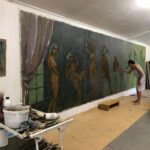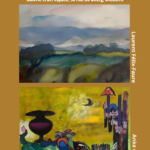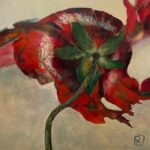Patrick Ducré – Sculptor of Light

N.B. When I first decided to create this blog it was to be all about painting only, but I soon came to the conclusion that this was not enough and that what I really wanted to do was to meet people who are imaginative, inventive and have a poetic approach to different kinds of art. In that respect la Drôme has much to offer and I believe that there are unsuspected numbers of artists in our region who produce works of cultural significance. My hope is to meet some of them, to talk to them about their work, their life as an artist and then share what I have discovered and learned with the readers of this blog.
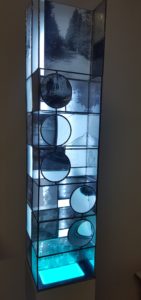
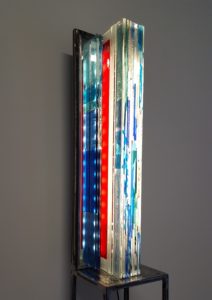
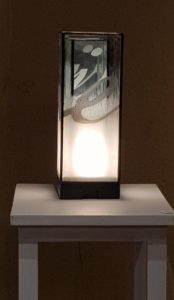
LE POËT LAVAL
This summer, in August, the art gallery Craft Espace from Dieulefit had the excellent idea of bringing three artists together, whose work slightly differs from that what is normally shown at exhibitions, in the castle of le Poët Laval. The donjon was built during the 12th century at the time of the Crusades by the Order of the Knights Hospitaller of Saint John of Jerusalem. It overlooks the old village that has been restored to its past splendour and has consequently been labelled “Les plus beaux villages de France.”
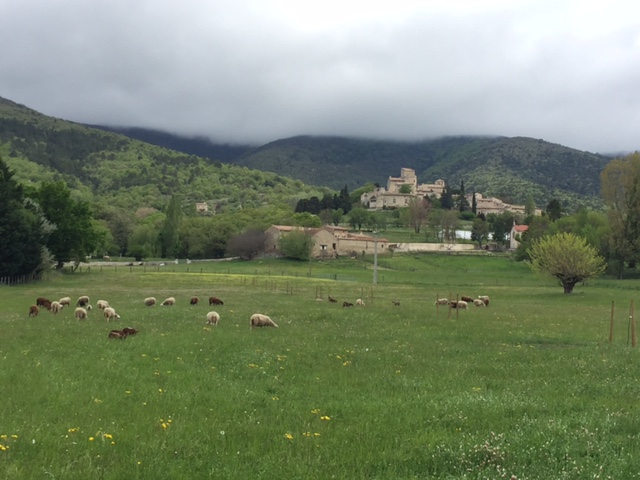
It was in this exceptional location where the stone walls testify to a rich and eventful past that the three artists exhibited their work. The chosen theme for the exhibition was “Art Narratives” with a view to highlighting the history of the castle as well as of the area which used to be well known for its arts and crafts activities. Anke de Vries’s collages and the nearly full-scale ceramic statues of women’s dresses of Jeannie Lucas illustrated the role of women throughout the ages. Jeannie Lucas’s work was also a reminder that ever since Gallo-Roman times the quarries in the surrounding area of the village were renowned for the quality of their clay, and that generation upon generation of potters had worked there. Patrick Ducré who is a stained-glass artist is the subject of my blog post today. The exhibition of his work was also a way of recalling that there had been a thriving glass industry in the area owing to the quality of the sand and all the white oaks, beech and fir trees. These produce the high-quality kind of ashes which are the Carbone elements required in order to melt glass and ensure its transparency.
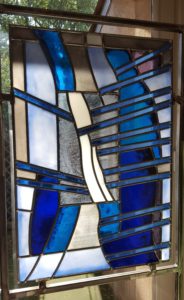
To stop and gaze up at stained glass windows when the light comes shining through liquefying the colours and endowing them with the brilliance of gems is a rare aesthetic experience. Paintings in oils, tempera, acrylics, watercolour in spite of its transparency, rarely achieve the same richness of hues and shades. There is something magic about glass especially when one knows what it is made of and what stained glass artists manage to do with it. It’s origins? The Roman historian Pliny the Elder has it that shipwrecked Phoenician sailors on a beach were the first to discover glass when they put a pot on a fire to cook a meal with a block of salt they had salvaged from their ship. The following morning the heat of the fire had melted the salt and the cooled off mass coagulated with sand had turned into glass. Pliny was wrong as glass goes back to the dawn of time, but he correctly describes its composition which is basically a mixture of silicon oxide, a component of sand and sodium chloride (salt).
Because one of his activities is to restore them Patrick Ducré is more likely than most people to appreciate the wonder of stained-glass windows like those of the middle ages. The Gothic style that followed Romanesque art and architecture around the 12th century was revolutionary and it heralded an unparalleled golden age for painted glass. Having found a way to build cathedrals that were much lighter in structure by means of ribbed vaults and flying buttresses to sustain them made it possible to frame vast expanses of glass in the walls, containing innumerable coloured depictions of scenes from the scriptures, designed to enlighten the faithful. Remarkable examples – among so many others – are the dazzling rose windows of 12th century cathedral of Notre Dame in Paris and the stained glass windows of the 13th century cathedral of Chartres. From then on the art of stained glass has known a lasting boom that has continued to this day. Think of its use during the Art Nouveau and Arts Deco periods or the wonderful works of Matisse, Gaudi, Chagall….Not to forget the “Cathedral all in volutes where the wind sings as a flute,“* the cathedral of Metz that boasts more than 6OOOm2 of glass structures making it the largest expanse of stained glass in the world and the most luminous place of worship in France. Besides the ancient ones, great modern artists like Jacques Villon, Roger Bissière and Marc Chagall were also commissioned to make contemporary stained windows for the cathedral.
In the Drôme unfortunately only two sets of stained-glass windows from before the French Revolution (1789) remain. They are not far from Valence and quite near to each other. The village church of Manthes (26260) has two 14th century windows representing Saint Peter and Saint Paul and the castle of Chavannes (26260) that features a man holding a sword and heraldic designs. However, there is a beautiful piece of contemporary minimalist work in Grignan (26230). The Belgium artist Ann Veronica Janssen was asked to make stained glass windows that would ensure “special lighting” in the 12th century Romanesque chapel that belongs to the community. To this end the glass was cut to size for each window but slightly smaller leaving natural light to come in through the open rim, like a halo. This created the very particular luminescence the backers had in mind.
PATRICK DUCRÉ
 A sculptor of light? When asked Patrick Ducré declares that this is what he would like to be. His path in life before establishing himself as a stained-glass artist in Montboucher-sur-Jabron (26740) has gone through several periods that were not always related to his art and his passion today. I wanted to know more about him. The following are his replies.
A sculptor of light? When asked Patrick Ducré declares that this is what he would like to be. His path in life before establishing himself as a stained-glass artist in Montboucher-sur-Jabron (26740) has gone through several periods that were not always related to his art and his passion today. I wanted to know more about him. The following are his replies.
You have done several things in your life. What decided you to become a stained-glass artist?
To begin with it was my choice of becoming a seminarian (to my mother’s despair who saw that “the man about the house” was leaving, my father having died earlier) and a chance meeting with a stained-glass artist during a few days off when I was at the seminary in Paris that influenced what laid further ahead. He was a master craftsman, we sympathized, and he kindly taught me the basics of stained-glass. At the seminary we were allowed to go on holiday three times every year, at Christmas, Easter and during the summer holidays. While we were away, we had to keep a kind of logbook that had to be signed every day by the priest of the church where I was obliged to serve mass. My mother liked travelling and I consequently visited many churches throughout France and Belgium. This diversity, but at the same time uniformity of churches depending on the periods they belonged to were my first lessons and my first links to stained glass.
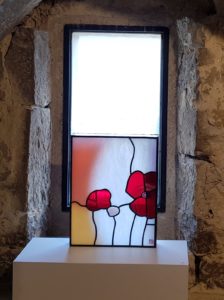 At the seminary I was the leader of the Saturday evening events and I rapidly became involved in theatre activities. I left the seminary and became an actor, and then a stage manager before going on to be a theatre director. It was in this capacity that I became the director of the “Train-Theatre” at the entrance of Valence, a beautiful location with 500 seats that was subsequently subsidized by the State. There were times when we enjoyed lots of success, moments of great liberty when we were able to explore new grounds and to organize meetings between the actors and the public. In a certain sense you might say that I was doing what I normally would have done as a priest: bringing people together by means of the “word”. But then I stepped up to a higher level of the hierarchy by accepting to become the director and the administrator of several theatres and this of course implied politics and a heavy load of administrative work. That is when I decided to make a clean break with the theatre and become a stained-glass artist. Again, I was fortunate. Due to circumstances, I met a master stained-glass maker in Beaucaire near Arles, and she was looking for an assistant.
At the seminary I was the leader of the Saturday evening events and I rapidly became involved in theatre activities. I left the seminary and became an actor, and then a stage manager before going on to be a theatre director. It was in this capacity that I became the director of the “Train-Theatre” at the entrance of Valence, a beautiful location with 500 seats that was subsequently subsidized by the State. There were times when we enjoyed lots of success, moments of great liberty when we were able to explore new grounds and to organize meetings between the actors and the public. In a certain sense you might say that I was doing what I normally would have done as a priest: bringing people together by means of the “word”. But then I stepped up to a higher level of the hierarchy by accepting to become the director and the administrator of several theatres and this of course implied politics and a heavy load of administrative work. That is when I decided to make a clean break with the theatre and become a stained-glass artist. Again, I was fortunate. Due to circumstances, I met a master stained-glass maker in Beaucaire near Arles, and she was looking for an assistant.
Stained glass windows have lines, colours and forms. You could very well have become a painter. Why glass? Was it because craftsmanship is required and that you like to work with your hands? Was the material appealing, or is it something else?
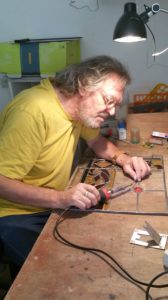 When I was young, I loved to paint and draw. I have never really stopped in the course of a life full of adventures. It’s easy, you just need a piece of paper and some colours. I suppose you know all about it. The reason I am drawn to stained glass is the light, the very essence of stained glass is light and colour. When I was the director of a theatre I met a stage manager who used to call himself “a sculptor of light.” I find the expression beautiful and it touches me very much. What I am striving at today when I make “objects of light” is exactly that, to trap the light by setting transparency against opacity, by creating reflections that bring out or suggest colours, or by multiplying them in order to play with various grades of depth, all the while telling a story, referring to an emotion, a feeling.
When I was young, I loved to paint and draw. I have never really stopped in the course of a life full of adventures. It’s easy, you just need a piece of paper and some colours. I suppose you know all about it. The reason I am drawn to stained glass is the light, the very essence of stained glass is light and colour. When I was the director of a theatre I met a stage manager who used to call himself “a sculptor of light.” I find the expression beautiful and it touches me very much. What I am striving at today when I make “objects of light” is exactly that, to trap the light by setting transparency against opacity, by creating reflections that bring out or suggest colours, or by multiplying them in order to play with various grades of depth, all the while telling a story, referring to an emotion, a feeling.
According to you what is the difference between an artist who makes stained glass and a craftsman who makes stained glass?
Today I would draw a rather fine-line between a craftsman and an artist. The craftsman makes useful objects, stained glass windows, lamps… the artist’s only concern is to create without any other purpose. The nuance can sometimes be extremely subtle for there are stained glass artists who make contemporary works that are authentic works of art and in other countries they will find their way to a museum. Even if the objects in question are only ornaments, I can greatly admire the degree of creativity that has gone into their making. In this respect I recommend the following site.
You went to the seminary and you visited many churches. Is there an element of spirituality underlying your decision to become a stained-glass artist?
With regard to spirituality I’m afraid the good fathers at the seminary have disgusted me forever when it comes to religious customs. Today I do practice a meditation technique based on “full conscious” breathing that helps me ground myself and get to the essentials. But working with stained glass is in itself a form of “meditation.” Whereas results are pretty rapidly obtained when you paint, every phase when working with stained glass requires a great deal of concentration as each of these phases can last quite a long time and necessitate a maximum of precision, when it comes to cutting out jigs, then cutting, trimming, grinding the glass, painting the oven, mounting and soldering the seals. It is only after all this has been done that results are obtained. The time that passes without knowing the result can therefore be long which is also the case when you meditate.
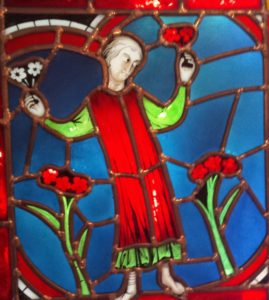
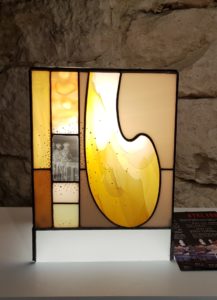
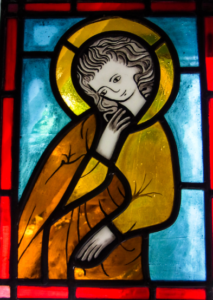
You use the same tools the craftsmen of the past did whereas modern techniques (3D printing for example) could help you work faster and who knows obtain innovating results?
You are right and new techniques even if I don’t often use them do appeal to me, the total fusion of glass and other methods that make it possible to imagine creating contemporary and future objects of art. It is the tool that guides the hand and not the other way around! However, the tools I use are all the more valuable because they are simple and go back a very long time. The triple blade scissors to cut out cardboard jigs, the diamond cutter, clamps to trim and grind the curved blade knife and the fid (lead opener), the soldering iron, they all existed and had the same use in the middle ages.
Why did you come to live in the Drôme and what are your plans for the future?
Coming to live in the Drôme was returning to a place where I had met many people, artists, technicians, spectators, community organisers, cultural animators, local officials, local representatives and I thought it would be amusing to greet all these friends in a totally different capacity. In this way I have the impression of closing a loop!
Posted in: Art
